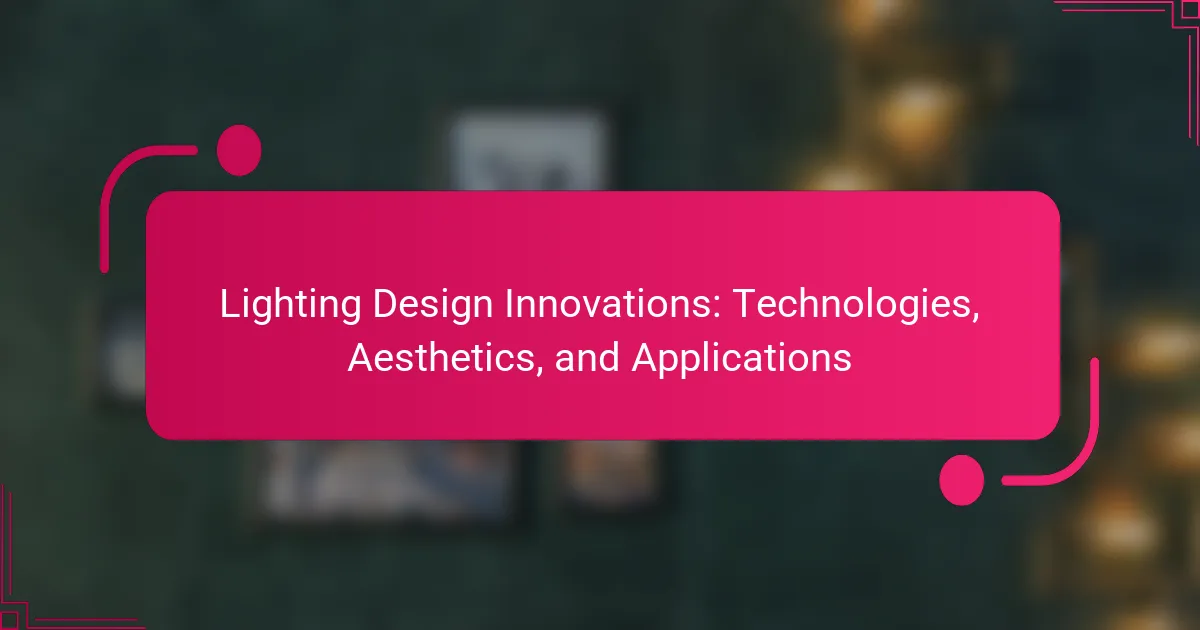Lighting design innovations are transforming spaces through advanced technologies, aesthetic integration, and sustainable practices. Smart lighting systems enhance control and energy efficiency. Aesthetic trends focus on minimalism and biophilic designs for improved well-being. Emerging applications prioritise human-centric lighting and eco-friendly materials, reshaping our interaction with light.
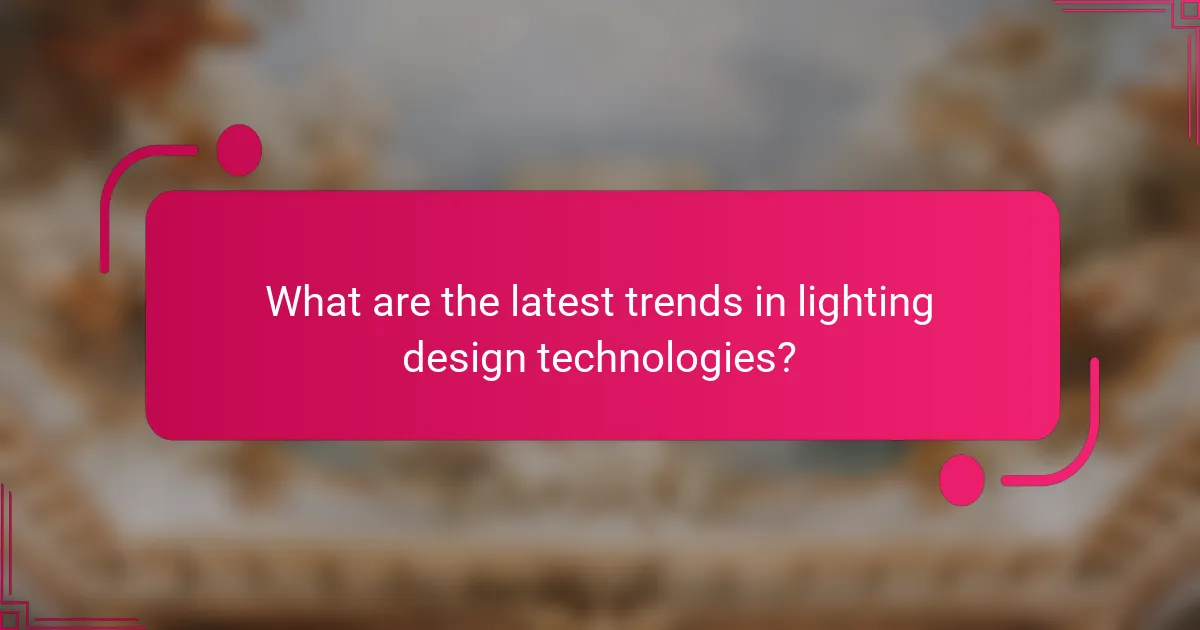
What are the latest trends in lighting design technologies?
Lighting design is evolving with trends in smart technologies, sustainability, and aesthetic integration. Smart lighting systems use IoT for enhanced control and energy efficiency. Sustainable materials and LED advancements reduce environmental impact while improving energy consumption. Aesthetic trends focus on minimalism and biophilic designs, creating harmonious spaces. Additionally, human-centric lighting adapts to natural rhythms, enhancing well-being. These innovations reshape how we perceive and interact with light in our environments.
How do LED advancements impact energy efficiency?
LED advancements significantly enhance energy efficiency by reducing power consumption and extending lifespan. These technologies utilise less electricity while providing superior brightness, resulting in lower energy bills and decreased carbon footprints. For instance, LED lights can last up to 25,000 hours compared to traditional bulbs, which typically last around 1,000 hours. This unique attribute of longevity contributes to fewer replacements and less waste. Additionally, advancements in LED design allow for better heat management, further improving energy efficiency. As a result, integrating LED technology into lighting design leads to sustainable and cost-effective solutions.
Which smart lighting systems are gaining popularity?
Smart lighting systems gaining popularity include Philips Hue, LIFX, and Wyze. These systems emphasise energy efficiency, customisation, and integration with smart home ecosystems.
Philips Hue offers extensive colour options and compatibility with various smart assistants. LIFX is known for its vibrant colours and no hub requirement. Wyze provides budget-friendly options with essential features, appealing to a wider audience.
As consumers prioritise sustainability, smart lighting systems that enhance energy efficiency are increasingly favoured. The integration of voice control and automation continues to drive interest in these innovative lighting solutions.
What role does IoT play in modern lighting design?
IoT significantly enhances modern lighting design by enabling smarter, more efficient systems. It allows for real-time monitoring, automated control, and integration with other smart devices. This connectivity improves energy efficiency, reduces costs, and enhances user experience through customisable lighting scenarios. For example, IoT-enabled lighting can adjust brightness based on occupancy or ambient light levels, optimising both comfort and energy savings. The unique attribute of IoT in lighting design is its ability to create responsive environments that adapt to user needs and preferences.
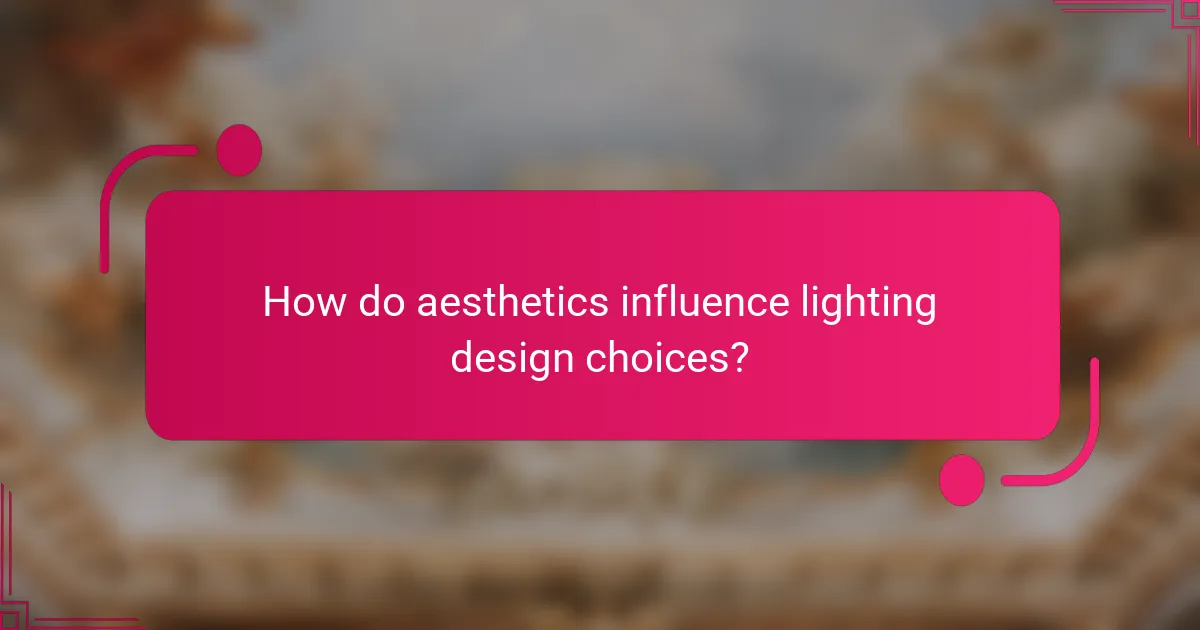
How do aesthetics influence lighting design choices?
Aesthetics significantly shape lighting design choices by influencing mood, style, and functionality. Designers prioritise visual appeal alongside technical performance, ensuring harmony with the overall environment. Innovative technologies, such as smart lighting, enhance aesthetic flexibility, allowing for customisable ambiance. The interplay of colour temperature and fixture design further amplifies aesthetic impact, creating spaces that resonate emotionally with users.
What are the psychological effects of lighting on space perception?
Lighting significantly influences space perception by affecting mood, attention, and spatial awareness. Effective lighting design can enhance the functionality and aesthetics of a space. For instance, warm lighting promotes relaxation, while bright, cool lighting enhances alertness. Studies show that optimal lighting can improve productivity and emotional well-being. Unique lighting innovations, such as dynamic LED systems, adapt to user needs, creating versatile environments. These advancements demonstrate the powerful psychological impact of lighting on human experiences within various spaces.
Which design styles are most compatible with innovative lighting?
Innovative lighting is most compatible with modern, minimalist, and industrial design styles. These styles emphasise clean lines, open spaces, and functional aesthetics, enhancing the impact of advanced lighting technologies. For example, smart lighting systems integrate seamlessly into minimalist interiors, while industrial styles benefit from bold fixtures that highlight their raw materials.
How do cultural preferences shape lighting aesthetics?
Cultural preferences significantly influence lighting aesthetics by dictating choices in colour, intensity, and design. Different cultures associate various colours with emotions and meanings, affecting how spaces are lit. For instance, warm tones may evoke comfort in some cultures, while cooler tones are preferred elsewhere for their modern appeal. Additionally, cultural traditions can shape the use of natural versus artificial light, impacting architectural choices. As a result, understanding these cultural nuances is essential for effective lighting design that resonates with diverse audiences.
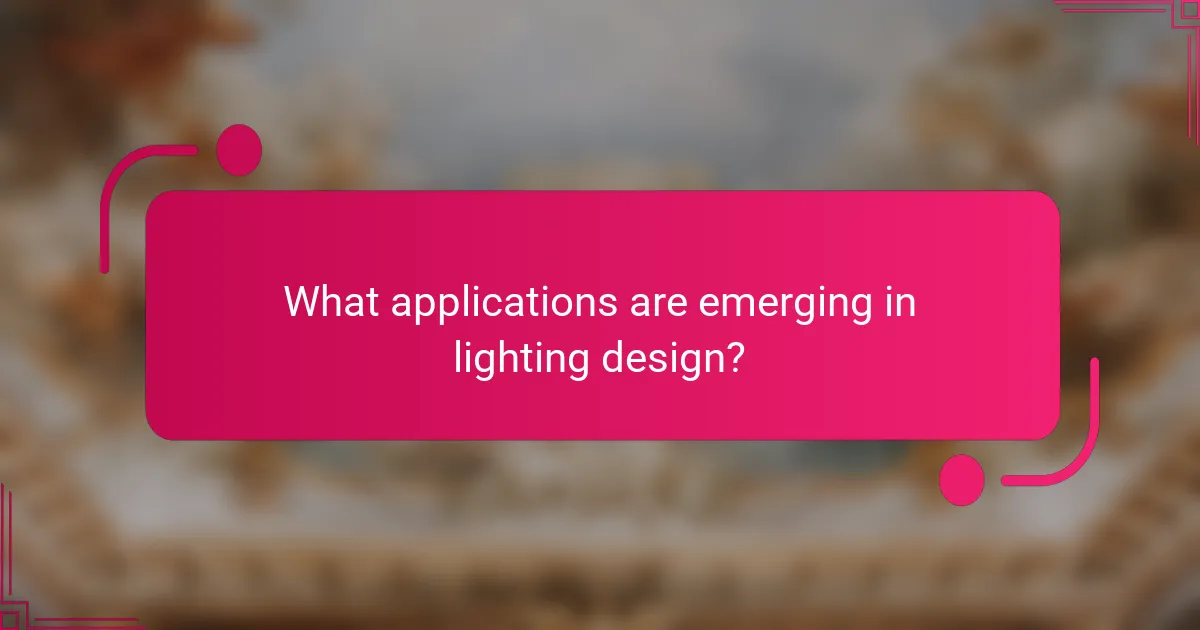
What applications are emerging in lighting design?
Emerging applications in lighting design include smart lighting systems, human-centric lighting, and sustainable solutions. Smart lighting enhances user control through automation and connectivity. Human-centric lighting adjusts colour temperature to support well-being and productivity. Sustainable solutions focus on energy efficiency and eco-friendly materials. These innovations reflect a shift towards functionality and environmental consciousness in lighting design.
How is lighting design transforming residential spaces?
Lighting design is transforming residential spaces by enhancing aesthetics, functionality, and energy efficiency. Innovations such as smart lighting systems allow for customisable ambiance and automation. LED technology offers long-lasting solutions with lower energy consumption, significantly reducing utility costs. Additionally, the integration of natural light through design strategies improves well-being and reduces reliance on artificial lighting. As a result, modern residential environments are becoming more adaptable and sustainable, reflecting individual preferences and lifestyles.
Which sectors are benefiting from innovative lighting solutions?
Various sectors are benefiting from innovative lighting solutions, including commercial, residential, healthcare, and hospitality. These advancements enhance energy efficiency, improve aesthetics, and support well-being.
In the commercial sector, smart lighting systems reduce energy costs and enhance productivity. The residential sector sees improvements in ambiance and user control through smart home integration. Healthcare facilities benefit from lighting that promotes patient recovery and staff efficiency. Hospitality venues utilise innovative designs to create memorable experiences for guests.
As a result, the adoption of innovative lighting solutions is transforming environments across multiple industries.
What are the challenges in implementing new lighting technologies?
The challenges in implementing new lighting technologies include high initial costs, integration with existing systems, and the need for specialised training. These factors can hinder widespread adoption despite the benefits of energy efficiency and improved aesthetics.
1. High initial costs may deter investment, even if long-term savings are evident.
2. Integration with existing infrastructure can be complex, requiring significant modifications.
3. Specialised training is necessary for staff to effectively utilise new technologies.
4. Rapid technological advancements can lead to obsolescence before full implementation.
5. Resistance to change from stakeholders can slow the adoption process.
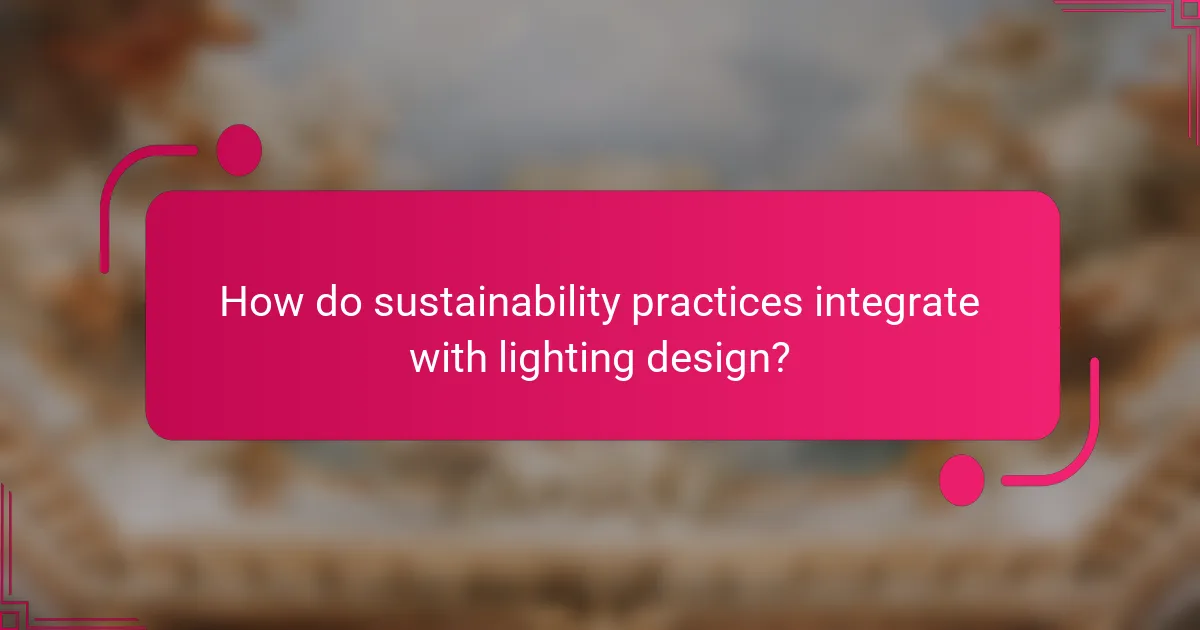
How do sustainability practices integrate with lighting design?
Sustainability practices significantly enhance lighting design by promoting energy efficiency and reducing environmental impact. Innovations like LED technology and smart lighting systems exemplify this integration. These solutions lower energy consumption, extend lifespan, and minimise waste. Additionally, biophilic design principles incorporate natural light, improving occupant well-being while aligning with sustainable goals. As a result, lighting design becomes a crucial element in creating eco-friendly spaces.
Which materials are leading the way in eco-friendly lighting?
Materials leading the way in eco-friendly lighting include LED technology, solar panels, and sustainable materials like bamboo and recycled plastics. These innovations reduce energy consumption and environmental impact.
LED lights are highly efficient, using up to 75% less energy than traditional bulbs. Solar lighting harnesses renewable energy, making it suitable for outdoor applications. Bamboo offers a renewable resource option, while recycled plastics help minimise waste.
What are the benefits of using renewable energy sources in lighting?
Using renewable energy sources in lighting offers significant benefits, including reduced environmental impact and lower energy costs. These sources, such as solar and wind, provide sustainable power, decreasing reliance on fossil fuels. As a result, they contribute to lower greenhouse gas emissions and improved air quality. Additionally, renewable energy systems can reduce operational expenses over time, making them economically advantageous. Adopting these technologies enhances energy efficiency and promotes a greener future in lighting design.
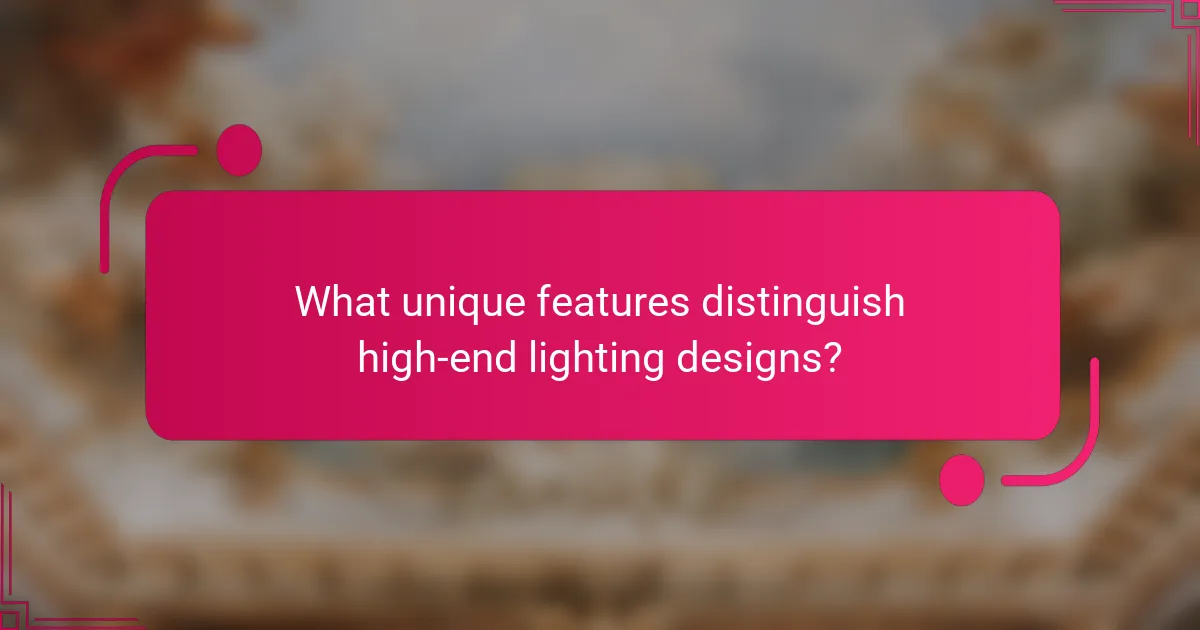
What unique features distinguish high-end lighting designs?
High-end lighting designs are distinguished by their innovative technologies, unique aesthetics, and versatile applications. These designs often incorporate smart technology, allowing for customisable lighting experiences. High-quality materials and craftsmanship enhance their visual appeal and durability. Unique features include energy-efficient LEDs that offer various colour temperatures and dynamic lighting effects. Additionally, many high-end designs focus on sustainability, utilising eco-friendly materials and production methods.
How do custom installations enhance user experience?
Custom installations significantly enhance user experience by providing tailored lighting solutions that meet specific needs. These innovations incorporate advanced technologies, allowing for dynamic control and customisation of lighting environments.
For instance, smart lighting systems enable users to adjust brightness and colour temperature through mobile applications or voice commands. This personalisation fosters comfort and improves mood, creating spaces that resonate with individual preferences.
Moreover, the aesthetic appeal of custom installations contributes to the overall ambiance of a space. Unique designs and innovative fixtures can transform ordinary environments into visually striking areas, enhancing both functionality and style.
Finally, the integration of energy-efficient technologies in custom lighting installations not only reduces energy consumption but also lowers utility costs, making them a sustainable choice for modern users.
Which brands are known for their innovative lighting solutions?
Brands known for their innovative lighting solutions include Philips, Osram, GE Lighting, Cree, and Acuity Brands. These companies leverage advanced technologies and design aesthetics to enhance functionality and energy efficiency. Philips offers smart lighting systems, while Osram focuses on LED technology. GE Lighting is recognised for its integration of IoT in lighting, and Cree specialises in high-performance LED solutions. Acuity Brands combines lighting with building management systems for improved energy use.
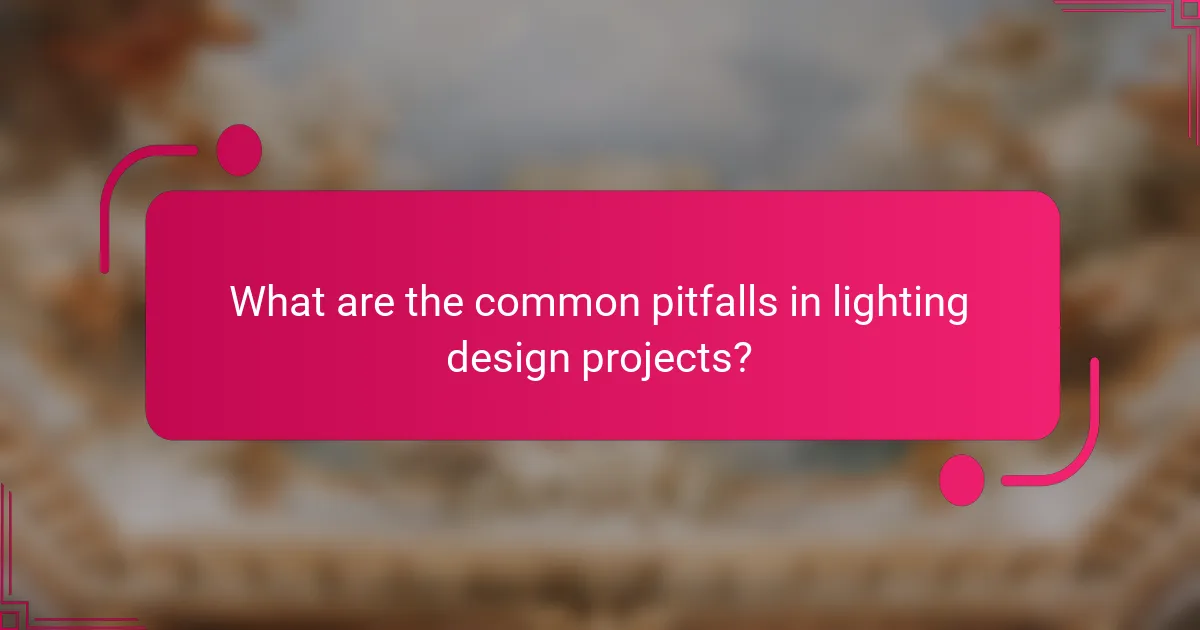
What are the common pitfalls in lighting design projects?
Common pitfalls in lighting design projects include inadequate planning, poor communication among stakeholders, and neglecting energy efficiency. Additionally, overlooking the importance of aesthetics can lead to unsatisfactory results. Failing to consider the unique attributes of the space, such as natural light availability, can also hinder effective design. Lastly, not staying updated with the latest technologies may result in missed opportunities for innovation.
How can designers avoid over-lighting spaces?
Designers can avoid over-lighting spaces by implementing layered lighting strategies. This approach combines ambient, task, and accent lighting to create balanced illumination.
Utilise dimmers and smart lighting controls to adjust brightness based on the time of day and activities. This flexibility enhances energy efficiency and user comfort.
Consider the use of natural light through windows and skylights, which can reduce reliance on artificial sources. Integrating light sensors can also help maintain appropriate lighting levels automatically.
Regularly assess lighting needs as space usage evolves. This ensures that lighting design remains functional and aesthetically pleasing without causing glare or excessive brightness.
What mistakes should be avoided when selecting fixtures?
Avoiding common mistakes in fixture selection enhances lighting design effectiveness. Focus on the following points:
1. Ignoring the space’s purpose and requirements can lead to ineffective lighting.
2. Overlooking energy efficiency may result in higher operational costs.
3. Neglecting fixture compatibility with existing systems can complicate installation.
4. Failing to consider aesthetics can disrupt the overall design theme.
5. Underestimating maintenance needs may lead to increased long-term expenses.
6. Overcomplicating control systems can confuse users and reduce functionality.
What best practices exist for optimizing lighting design?
To optimize lighting design, focus on energy efficiency, user comfort, and adaptability. Incorporate smart technologies like sensors and controls to enhance functionality. Utilise layered lighting techniques to create depth and flexibility in spaces. Consider the psychological effects of colour temperature on mood and productivity.
